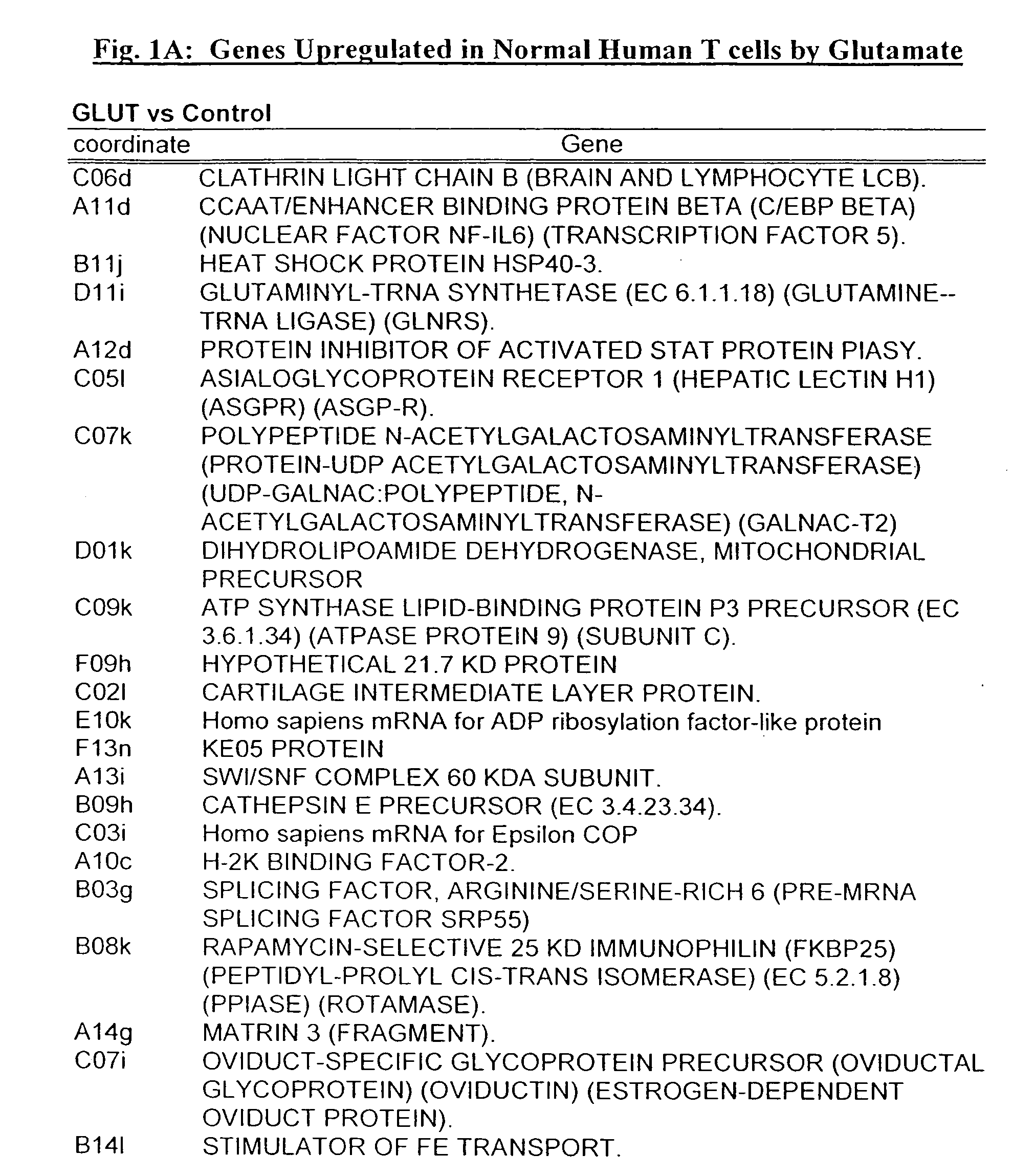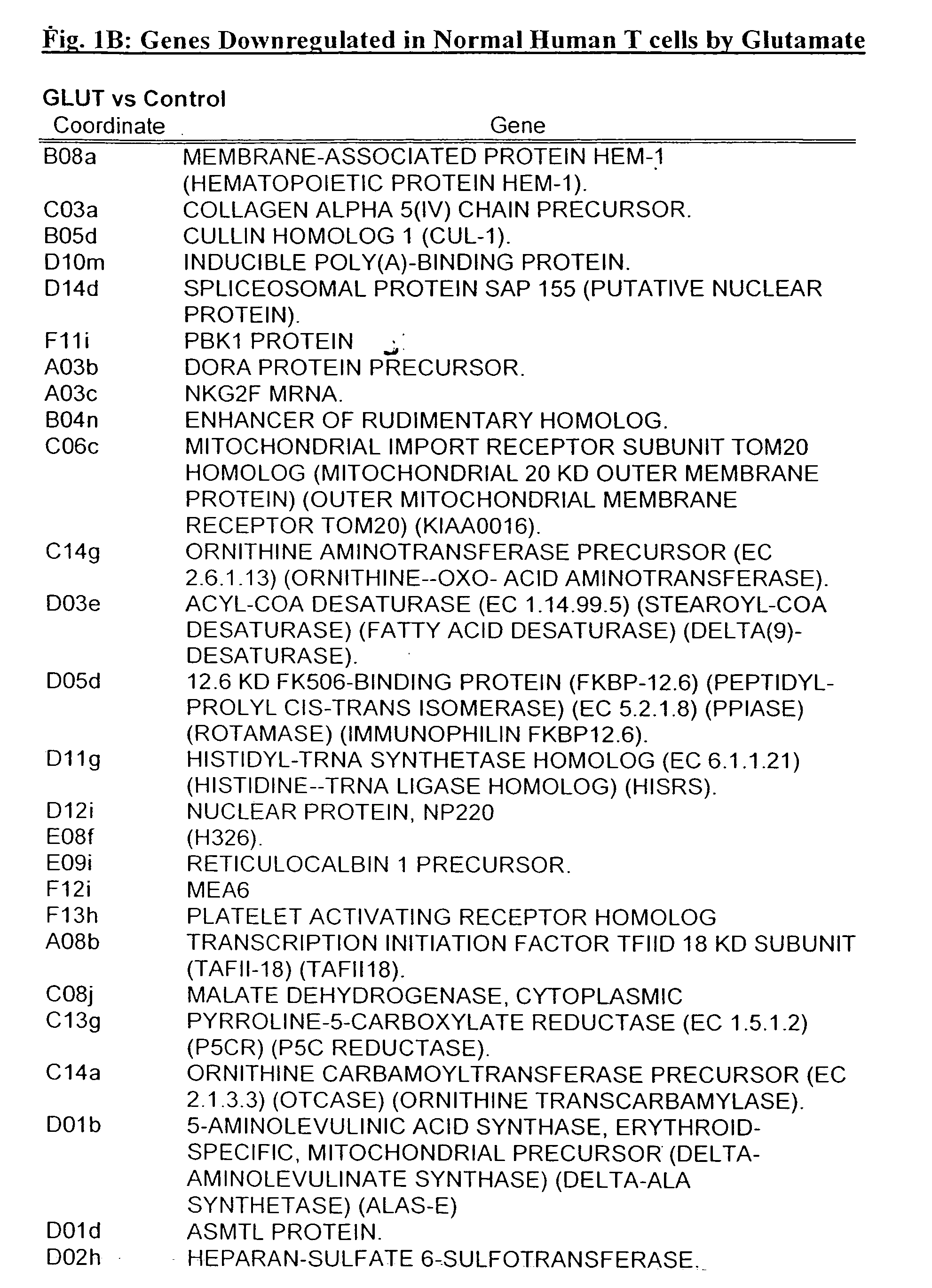Methods of and pharmaceutical compositions for modulating T-lymphocyte adhesion, migration, gene expression and function by Glutamate and analogs thereof
- Summary
- Abstract
- Description
- Claims
- Application Information
AI Technical Summary
Benefits of technology
Problems solved by technology
Method used
Image
Examples
example 1
[0313] T-Cells Respond to Direct Stimulation With Glutamate by Initiation, Modulation or Suppression of de Novo Gene Expression
[0314] To explore the possible direct effects of Glutamate on gene expression by T-cells, resting human peripheral T-cells were exposed to Glutamate (10 nM) for 72 hours. Poly A+ RNA was prepared from both Glutamate-treated and untreated cells and reverse transcribed to 32P-labeled cDNA. Using an Atlas human cDNA expression array (i.e. a positively charged nylon membrane spotted with 1200 different human cDNAs) for identification of effected genes, the reverse transcribed products were characterized by hybridization to the atlas membranes. The differential pattern of expression between untreated cells and Glutamate-treated cells was visualized by autoradiography, and quantified by densitometry [see FIGS. 1A and 1B-D for a continuous list of examples of up- and downregulated genes]. The results revealed that Glutamate induced the over expression of mRNA enco...
example 2
[0317] Glutamate Induces Cytokine Secretion in Resting Human T-Cells.
[0318] T-cell activation is characterized by numerous responses, such as proliferation, adhesion, chemotaxis and cytokine secretion. It is via the release of specific factors such as the cytokines, that the cells of the immune system communicate with each other to coordinate appropriate immune and inflammatory responses. Typically, cytokine secretion in unstimulated T-cells is minimal, but can be strongly induced by activation with well-known inducers such as a specific antigens, mitogens, cytokines, and TCR activating antibodies. T-helper cell subpopulations Th0, Th1 and Th2 cells are characterized by the types of cytokines which they synthesize and secrete: Pluripotent, non-committed Th0 cells secrete a variety of cytokines, committed Th1 typically secrete IL-2 and IFN-γ, and Th2 secrete IL-4, IL-5, and IL-10, IL-13 and other Th2 cytokines. Many normal and pathological conditions are associated with specific cyt...
example 3
[0325] Glutamate Induces T-Cell Adhesion to Extra Cellular Matrix Proteins Via Specific Ionotropic Glutamate Receptor.
[0326] To study the functional consequences of Glutamate mediated T-cell activation, the ability of Glutamate-treated normal human T-cells to adhere to laminin and fibronectin was assessed. It is widely accepted that only activated T-cells can bind to components of the basement membrane and extracellular matrix, such as laminin and fibronectin. In order to determine Glutamate's ability to induce such cell binding, the adhesion to laminin- or fibronectin-coated microtiter plates of Glutamate-treated cells was compared to that of untreated cells (negative control, BG).
[0327]FIG. 7A demonstrates the relative proportions of treated and untreated fresh human T-cells adhering to fibronectin, expressed in terms of OD450. Incubation of the cells with physiological concentrations (10−8M) of Glutamate (30 minutes) clearly induces a significant increase in fibronectin and lam...
PUM
 Login to View More
Login to View More Abstract
Description
Claims
Application Information
 Login to View More
Login to View More - R&D
- Intellectual Property
- Life Sciences
- Materials
- Tech Scout
- Unparalleled Data Quality
- Higher Quality Content
- 60% Fewer Hallucinations
Browse by: Latest US Patents, China's latest patents, Technical Efficacy Thesaurus, Application Domain, Technology Topic, Popular Technical Reports.
© 2025 PatSnap. All rights reserved.Legal|Privacy policy|Modern Slavery Act Transparency Statement|Sitemap|About US| Contact US: help@patsnap.com



